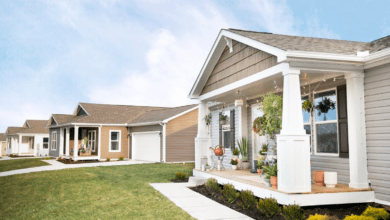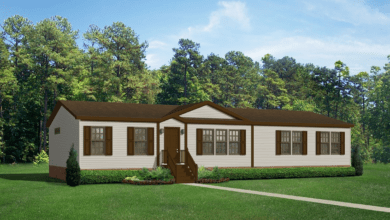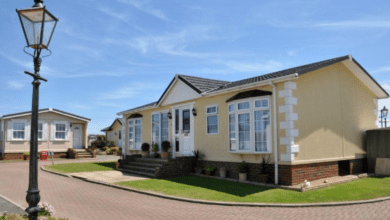Manufactured Homes: The Future of Affordable Housing?

In recent years, the conversation surrounding affordable housing has reached a crescendo, with more and more individuals and families feeling the pinch of rising rents and stagnant wages. As the housing market continues to evolve, manufactured homes have emerged as a promising solution to this pressing issue, offering a blend of affordability, quality, and sustainability that traditional housing options often struggle to match.
Understanding Manufactured Homes
Manufactured homes, also known as mobile homes or trailers, are residential structures that are constructed off-site in a factory setting. Unlike traditional site-built homes, which are built on the property where they will permanently stand, manufactured homes are assembled elsewhere and then transported to their final location.
Here are the key points to grasp about manufactured homes:
- Prefabrication Process:
- Manufactured homes are built indoors, away from the elements, ensuring consistent quality control during construction.
- Skilled workers assemble the components, including walls, floors, and roofs, following strict building codes and safety standards.
- Once complete, the home is transported to its destination, either on its own wheels (if mobile) or via a flatbed truck.
- Transport and Installation:
- The transportation process involves carefully moving the fully constructed home to its permanent site.
- Upon arrival, the home is placed on a foundation (either a concrete slab or piers) and secured.
- Utilities (such as water, electricity, and sewage) are connected, and any finishing touches are completed.
- Design and Customization:
- Manufactured homes come in various sizes and layouts, from single-wide (narrow) to double-wide (wider) models.
- Buyers can choose from different floor plans, exterior finishes, and interior features.
- Customization options allow homeowners to personalize their space, making it uniquely theirs.
- Quality Improvements:
- While older mobile homes may have faced quality concerns, today’s manufactured homes adhere to rigorous building standards.
- Improved materials, energy-efficient features, and modern design elements contribute to their enhanced quality.
- Many manufacturers prioritize safety, durability, and aesthetics to create comfortable living spaces.
- Affordability and Accessibility:
- Manufactured homes are often more affordable than traditional homes, making homeownership accessible to a broader range of people.
- They are particularly popular for first-time buyers, retirees, and those seeking cost-effective housing solutions.
- Communities dedicated to manufactured homes provide amenities and a sense of community.
The Evolution of Manufactured Homes
Gone are the days of flimsy construction and cookie-cutter designs. Manufactured homes now boast a wide range of architectural styles, floor plans, and customizable features, allowing homeowners to personalize their living space to suit their needs and preferences. Advances in construction technology have also led to improvements in energy efficiency, durability, and overall quality, making modern manufactured homes a viable alternative to traditional stick-built houses.
In the not-so-distant past, manufactured homes were often associated with flimsy construction, limited design options, and a lack of durability. However, times have changed, and today’s manufactured homes have undergone a remarkable transformation. Here’s how they’ve evolved:
- Architectural Diversity:
- Gone are the cookie-cutter designs of yesteryears. Modern manufactured homes now offer a wide range of architectural styles, from contemporary to traditional.
- Homeowners can choose from various rooflines, exterior finishes, and window configurations, allowing them to express their unique tastes.
- Customization Opportunities:
- Unlike their predecessors, today’s manufactured homes are highly customizable. Buyers can personalize their living space by selecting features such as flooring, cabinetry, countertops, and fixtures.
- Floor plans are adaptable, accommodating different family sizes and lifestyles. Whether you need an open-concept layout or separate rooms, there’s a design to fit your needs.
- Energy Efficiency:
- Advances in construction technology have significantly improved energy efficiency. Modern manufactured homes come equipped with better insulation, energy-efficient windows, and high-quality HVAC systems.
- Homeowners can enjoy reduced utility bills and a smaller environmental footprint.
- Durability and Quality:
- Manufacturers now use higher-grade materials, ensuring greater durability and longevity.
- Stringent building codes and quality control processes contribute to the overall quality of manufactured homes.
- These homes are built to withstand various weather conditions, making them suitable for diverse climates.
- Affordability and Accessibility:
- Manufactured homes remain an affordable housing option, making homeownership achievable for many.
- They are particularly popular for retirees, first-time buyers, and those seeking a cost-effective alternative to traditional stick-built houses.
- Communities dedicated to manufactured homes provide amenities and a sense of community.
Affordability and Accessibility
One of the most compelling aspects of manufactured homes is their affordability. Compared to traditional homes, which often require significant time and resources to build, manufactured homes can be produced more quickly and at a fraction of the cost. This cost savings is passed on to the consumer, making manufactured homes an attractive option for first-time homebuyers, retirees, and anyone looking to downsize without breaking the bank.
Manufactured homes indeed offer a unique blend of affordability and accessibility. Let’s explore these aspects further:
- Cost-Effective Construction:
- Manufactured homes are constructed in a controlled factory environment, which streamlines the building process.
- The efficient assembly line approach reduces labor costs, material waste, and construction time.
- As a result, manufactured homes are significantly more affordable than their site-built counterparts.
- Lower Purchase Price:
- Buyers can acquire a manufactured home at a fraction of the cost of a traditional house.
- This affordability opens doors for first-time buyers who might otherwise struggle to enter the housing market.
- Retirees seeking to downsize or individuals looking for budget-friendly housing options find manufactured homes appealing.
- Accessible Homeownership:
- Manufactured homes provide an accessible path to homeownership.
- They are an excellent solution for those who want to own property without the financial burden of a large mortgage.
- Communities dedicated to manufactured homes often offer amenities, creating a sense of community and shared living experiences.
- Flexibility and Mobility:
- Manufactured homes can be placed on leased land in mobile home parks or on privately owned property.
- Their mobility allows homeowners to relocate if needed, making them suitable for those who value flexibility.
- Energy Efficiency and Sustainability:
- Many modern manufactured homes incorporate energy-efficient features, such as better insulation and efficient HVAC systems.
- Lower utility bills contribute to long-term affordability.
- Additionally, the controlled factory environment minimizes material waste, aligning with sustainable practices.
Sustainability and Eco-Friendliness
In addition to being cost-effective, manufactured homes are also more environmentally friendly than their traditional counterparts. Many manufacturers now offer green building options, such as energy-efficient appliances, sustainable materials, and renewable energy systems, which can help reduce utility bills and minimize environmental impact. By choosing a manufactured home, homeowners can enjoy the peace of mind of knowing that they are living in a more sustainable and eco-conscious manner.
Beyond affordability, manufactured homes embrace sustainability and eco-friendliness. Let’s explore how:
- Green Building Options:
- Manufacturers prioritize eco-conscious features, such as energy-efficient appliances and lighting.
- Sustainable materials, like recycled content or responsibly sourced wood, contribute to a smaller environmental footprint.
- Energy Efficiency:
- Modern manufactured homes incorporate insulation, efficient HVAC systems, and double-pane windows.
- Reduced energy consumption translates to lower utility bills and less strain on natural resources.
- Renewable Energy Integration:
- Homeowners can install solar panels or wind turbines to generate clean energy.
- These renewable systems reduce reliance on fossil fuels and contribute to a greener lifestyle.
- Reduced Waste:
- Factory construction minimizes material waste compared to on-site building.
- Efficient production processes ensure that excess materials are repurposed or recycled.
- Community Living:
- Manufactured home communities often promote shared amenities and green spaces.
- Residents can participate in community gardens, composting, and conservation efforts.
Overcoming Stereotypes
Despite their many benefits, manufactured homes still face lingering stereotypes and misconceptions. Some people may still associate them with poverty or transience, while others may worry about the resale value or long-term durability of manufactured homes. However, as the industry continues to innovate and improve, these stereotypes are gradually being dispelled, and manufactured homes are gaining recognition as a viable and desirable housing option for people from all walks of life.
Overcoming Stereotypes: Redefining Manufactured Homes
Despite their rich history and practical advantages, manufactured homes have often been burdened by stereotypes and misconceptions. Let’s address these preconceived notions and shed light on the truth behind modern manufactured homes:
- The Stigma of Poverty:
- Stereotype: Some associate manufactured homes with poverty or financial struggle.
- Reality: Today’s manufactured homes span a wide spectrum, from budget-friendly options to high-end custom designs. They cater to diverse income levels and lifestyles.
- Fact: Manufactured homes offer an affordable pathway to homeownership, allowing people to invest in property without breaking the bank.
- Transient Living Perception:
- Stereotype: Mobile homes evoke images of impermanence and transience.
- Reality: While some manufactured homes are mobile, many are permanently placed on private land or within communities.
- Fact: Permanent foundations and community living provide stability, fostering a sense of belonging and permanence.
- Resale Value Concerns:
- Stereotype: Buyers worry that manufactured homes depreciate rapidly and have poor resale value.
- Reality: Like any property, resale value depends on factors such as location, maintenance, and market conditions.
- Fact: Well-maintained manufactured homes can appreciate over time, especially in desirable areas.
- Quality and Durability Doubts:
- Stereotype: Skepticism persists about the durability and construction quality of manufactured homes.
- Reality: Stringent building codes regulate the industry, ensuring safety and structural integrity.
- Fact: Advances in materials and construction techniques have elevated the quality of modern manufactured homes.
- Environmental Impact:
- Stereotype: Some assume manufactured homes are less eco-friendly.
- Reality: Green building options, energy-efficient features, and sustainable materials are increasingly common.
- Fact: Many manufactured homes prioritize energy efficiency, reducing utility costs and environmental impact.
Conclusion
In conclusion, manufactured homes represent a promising solution to the pressing need for affordable housing. With their affordability, quality, and sustainability, manufactured homes offer a compelling alternative to traditional stick-built houses. As the demand for affordable housing continues to grow, manufactured homes are poised to play an increasingly important role in meeting the needs of homeowners across the country.


